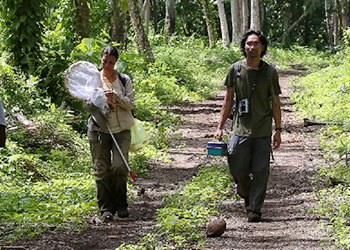J. Albert C. Uy makes the trip about twice a year, flying first to Guadalcanal, where U.S. Marines once fought a famous battle more than 60 years ago, then to Makira, the southernmost atoll in the Solomon Islands chain. There, he lives and works for up to three weeks at a stretch, studying a particular group of island inhabitants who, though small, may hold a big secret to understanding the process of speciation.
Uy has documented how a genetic mutation has caused two closely related populations of monarch flycatcher birds to split into separate species.
“It’s a one-in-a-million occurrence,” said Uy, the Aresty Chair in Tropical Ecology in the University of Miami College of Arts and Sciences, who has conducted research in the Solomon Islands for the past eight years. “What’s most apparent about the change is the color of their plumage and the kinds of songs they sing.”
He studied two populations of monarch flycatchers—those on Makira, which have all black feathers and chestnut-colored bellies, and those on a nearby island, which are entirely black. He investigated what gene may be responsible for the different plumage, discovering that the two populations of birds had different forms of the melanocortin-1 receptor gene, which regulates the pigment that determines the color of their skin and feathers.
“But the really important question was whether it matters to the birds that they look different,” said Uy. To find out, he created all-black and chestnut-bellied taxidermy models of monarch flycatchers and placed them in the mating territories of each population. He also recorded the songs of each population.

Al Uy and researcher Floria Mora-Kepfer return to camp from field work in Kirakira, Makira Island. (Photo by Day's Edge Productions)
“I wanted to see if they recognized the birds as their own species,” Uy said.
All-black male flycatchers attacked the all-black models, but when they encountered chestnut-bellied models, they were less likely to attack. The same situation played out for the chestnut-bellied flycatchers—a strong indication that the two populations had become two different species.
Uy has been investigating the origin of new species ever since he read and became fascinated by the research of legendary evolutionary biologists Jared Diamond and Ernst Mayr as a graduate student at the University of Maryland.
“Mayr wrote several books and papers describing what he saw in the Solomons,” said Uy. “He was one of the first to propose that some of these bird species are on the verge of becoming new species. I like to say that I’ve been standing on the shoulders of giants like Mayr, taking up where they left off and visiting some of these islands to see if those birds are, indeed, becoming new species.”
The Solomon Islands are ideal for studying speciation, Uy says, because of their remoteness. “They’re evolutionary experiments,” he explained. “Each, presumably, is independent. So whatever is on that island is going to change on its own.”
But observing that process in the wild is like winning the lottery. Fortunately for Uy, he’s hit the jackpot, studying Makira’s population of monarch flycatchers just as they arrive at that evolutionary rift.
When he first arrived unannounced in Makira eight years ago, island residents greeted him with skepticism, believing he was one of the many loggers who have stripped their land of trees and contributed to deforestation. But he quickly won their trust, and today, is considered one of the locals. He learned to speak Pijin, the English-based Creole language spoken in the Solomon Islands by about 300,000 of its residents, and Joyce and John Murray, Uy’s adoptive family in the Solomons, named their grandson after him.
“You eat what they eat. You do what they’re doing, and eventually you become part of the culture,” said Uy.
The Murray’s clan own a small three-acre island about 100 yards offshore from Makira where Uy has built a research station from forest material. Uy and his team of student scientists and colleagues use the facility as a base of operations whenever they visit. The site also serves as a base of operations for a UM Study Abroad course taught by Uy and his wife, Floria Mora-Kepfer, a Department of Biology researcher. While only five UM students participated in last year’s inaugural course on “Ecology, Evolution and Conservation,” Uy anticipates that number will double when the class is offered next summer.
Uy’s work in the Solomons is further evidence that the 11,000-square-mile island group, which lies northeast of Australia in the South Pacific, is the key to understanding speciation.
An upcoming one-hour documentary will explore Uy’s work there, following the Filipino-born UM researcher and his students as they examine how bird populations in the islands are changing. Islands of Creation, produced by Day’s Edge Productions, is scheduled to be released in late 2014 or early 2015.
Uy’s research efforts could help answer some of the questions humankind has asked for centuries. “Why isn’t there a single species of bird that lives all over the planet? Or why isn’t there a single species of plant? Why are there so many different forms as opposed to one really good form that does everything well?” asked Uy. “One of the things we’re trying to answer is why is the world so diverse? Why do we have all these different things? Understanding the mechanisms of change may help us answer those questions.”

